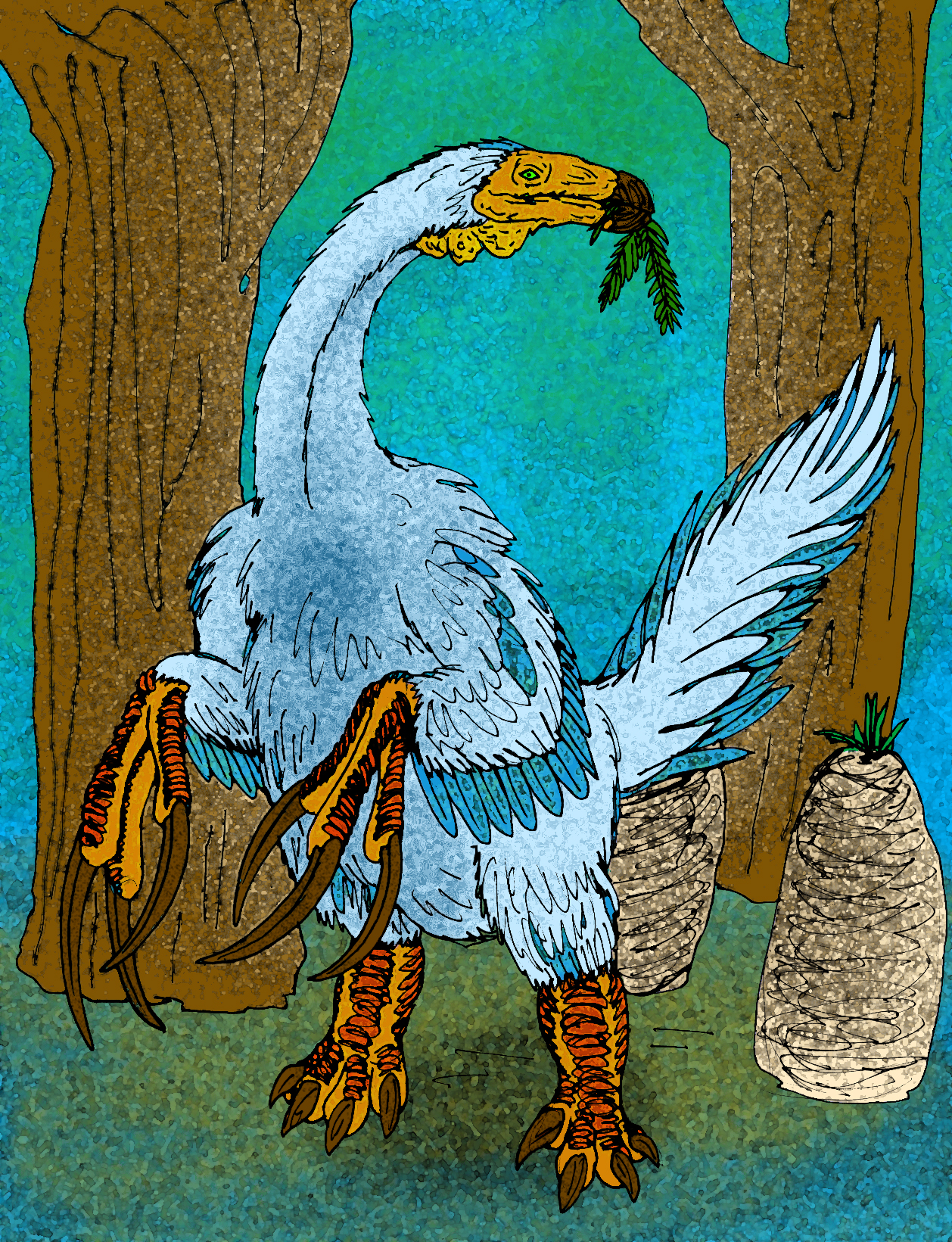- Therizinosaurus
Taxobox
name = "Therizinosaurus"

fossil_range = fossil range|72|68Late Cretaceous
regnum =Animal ia
phylum = Chordata
classis = Sauropsida
superordo =Dinosauria
ordo =Saurischia
subordo =Theropoda
familia =Therizinosauridae
genus = "Therizinosaurus"
genus_authority = Maleev, 1954
subdivision_ranks =Species
subdivision = "T. cheloniformis" Maleev, 1954 (type)"Therizinosaurus" (pronEng|θɛˌrɪzɨnoʊˈsɔrəs 'scythe lizard', from the Greek "therizo" meaning 'to reap' or 'to cut off' and "sauros" meaning 'lizard') is a
genus of very largetheropod dinosaur . Known from very incomplete remains, it is estimated to have grown up to 9.6 meters (32 ft) long and reach 3-6 tonnes (3-7short ton s) in weight.Mortimer, M. (2003), [http://dml.cmnh.org/2003Jul/msg00355.html "And the Largest Theropod Is...."] , discussion group, The Dinosaur Mailing List, viewed July 21, 2003. http://dml.cmnh.org/.] "Therizinosaurus" lived in the lateCretaceous Period (lateCampanian -earlyMaastrichtian stages, around 70million years ago ), and was one of the last and largest representatives of its unique group, theTherizinosaur ia. Itsfossil s were first discovered inMongolia and they were originally thought to belong to aturtle -like reptile (hence thespecies name, "T. cheloniformis" — "turtle-formed").Discovery and species
The first
fossil remains of "Therizinosaurus" were discovered in the late 1940s by a jointSoviet -Mongolianfossil expedition, in theNemegt Formation of southwesternMongolia . The expedition unearthed several giantclaw s that measured up to a meter in length. These were described by Russian paleontologistEvgeny Maleev in 1954, who thought they belonged to a large,turtle -likereptile .Maleev, E.A. (1954). "New turtle−like reptile in Mongolia [in Russian] ." "Priroda", 1954(3): 106–108.] However, it was not known what creature these belonged to until the early 1950s, when further expeditions unearthed more fossils: several more sets of claws and parts of the fore and hind limbs. Subsequent finds in northernChina allowed paleontologists to assemble the general skeletal structure of the animal, which was determined to be a dinosaur and not a turtle.The discovery of the enigmatic "segnosaurs", including "
Alxasaurus " in 1993 and "Beipiaosaurus " in 1996, helped clarify the relationships of "Therizinosaurus". Various theories had been proposed to explain the ancestry of the segnosaurids, with some scientists even suggesting they were descendents of the sauropodomorphs - but these new, well-preserved finds, which provided details about the bird-likepelvis , feet and skulls, helped confirm that segnosaurids belonged to the same group oftheropod dinosaurs as "Therizinosaurus" (and were therefore re-named therizinosaurids), and that therizinosaurs were, more specifically, advanced, herbivorous maniraptoran theropods.Characteristics
Though the fossil remains of "Therizinosaurus" are incomplete, inferences can be made about its physical characteristics based on related therizinosaurids. Like other members of its family, "Therizinosaurus" probably had a small skull atop a long neck, with a
biped al gait and a heavy, deep body (as evidenced by the widepelvis of other therizinosaurids). Its forelimbs may have reached a length of 2.5 meter (8 ft) long.Barsbold, R. (1976c). "New data on "Therizinosaurus" (Therizinosauridae, Theropoda) [in Russian] ." In Devâtkin, E.V. and N.M. Ânovskaâ (eds.), Paleontologiâ i biostratigrafiâ Mongolii. "Trudy, Sovmestnaâ Sovetsko−Mongol’skaâ paleontologičeskaâ kspediciâ", 3: 76–92.] Its hind limbs ended in four weight-bearing toes, unlike other theropod groups, in which the first toe was reduced to adewclaw .The most distinctive feature of "Therizinosaurus" was the presence of three gigantic
claw s on each digit of its front limbs. These were especially large in "Therizinosaurus", and while the largest claw specimens are incomplete, they probably reached just under 1 meter (3.28 feet) in length.Barsbold, R. (1983). "Carnivorous dinosaurs from the Cretaceous of Mongolia [in Russian] ." "Trudy, Sovmestnaâ Sovetsko−Mongol’skaâ paleontologičeskaâ èkspediciâ", 19: 1–120.] Rozhdestvensky, A.K. (1970). "On the gigantic claws of mysterious Mesozoic reptiles." "Paleontologischeskii Zhurnal", 1970(1): 131-141.] Rozhdestvensky, A.K. (1970). "Giant claws of Enigmatic Mesozoic Reptiles." "Paleontology Journal", 4(1): 117-125.]Paleobiology
The feeding habits of "Therizinosaurus" are unknown, since no skull material has ever been found that could indicate its diet. However, like other therizinosaurs, it was probably primarily herbivorous.Svarney, T.E. and Svarney, P.B. (2003). "The Handy Dinosaur Answer Book", 1st ed. Canton, MI: Visible Ink Press.] There are other possible functions that could have been served by the claws of "Therizinosaurus", such as defense against predators (e.g. the contemporary "
Tarbosaurus ") and in intraspecific fighting, such as fighting for territory or for mating. The claws may even have served all these functions.References
Wikimedia Foundation. 2010.
